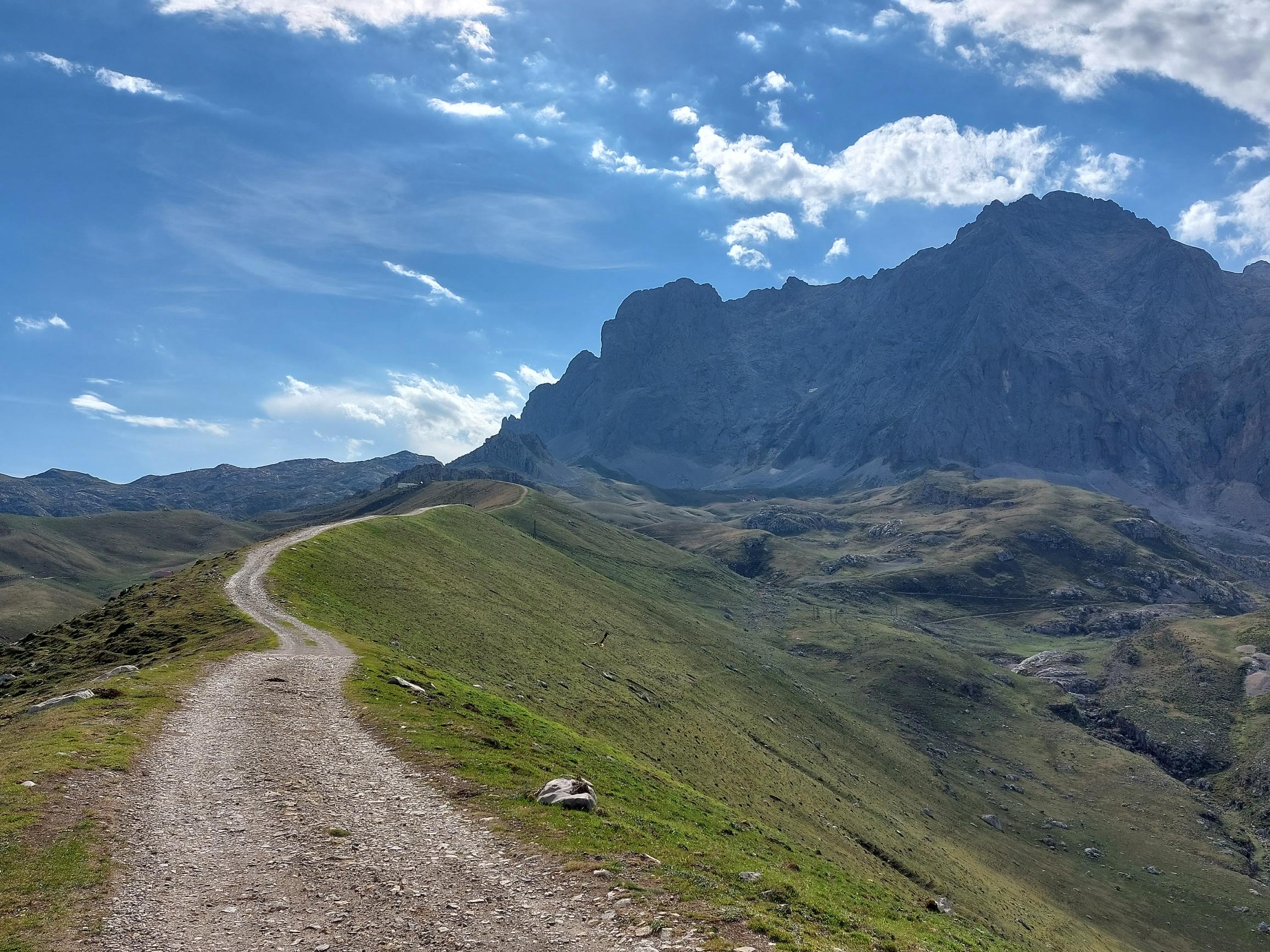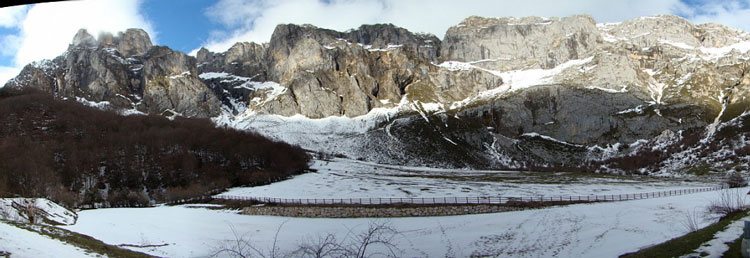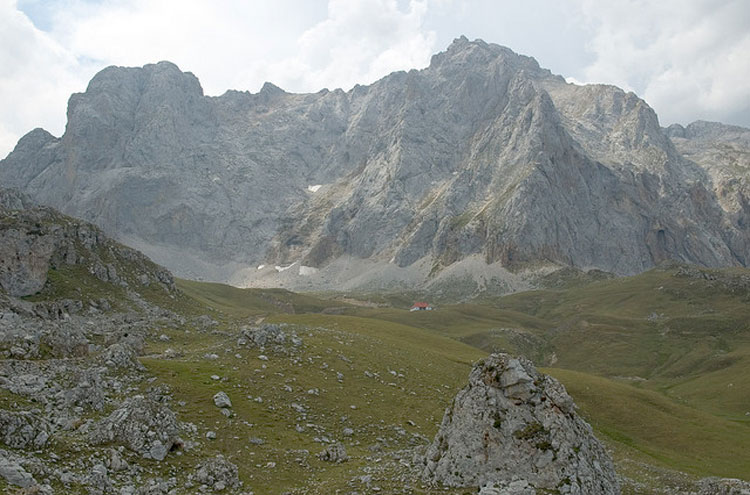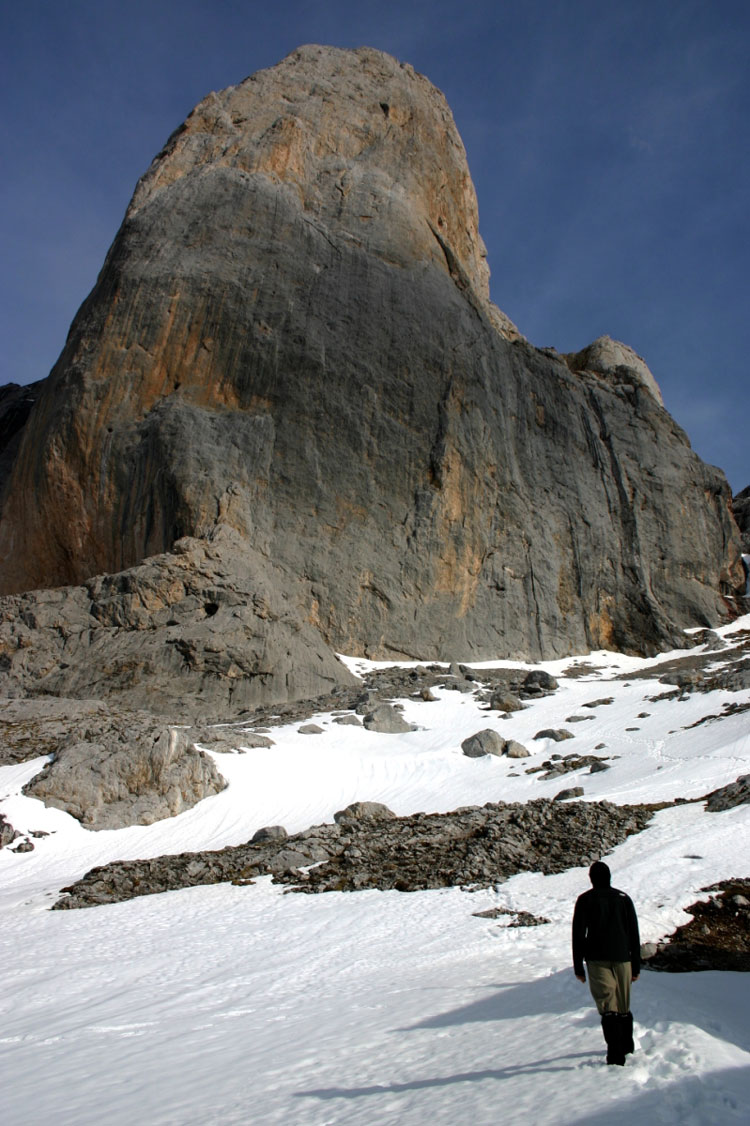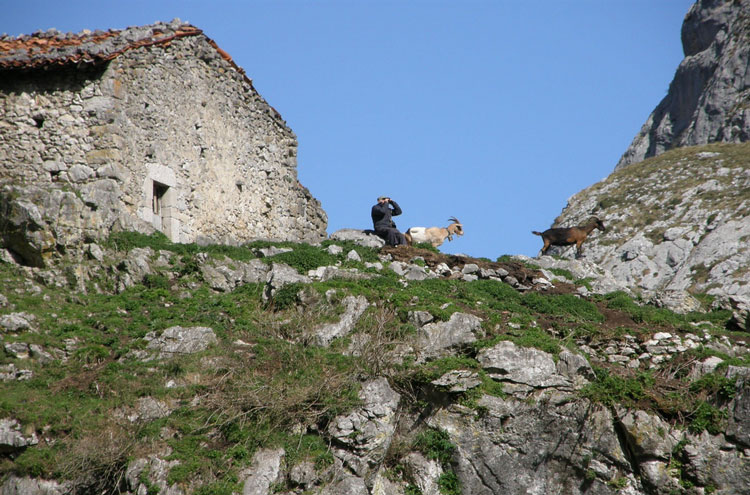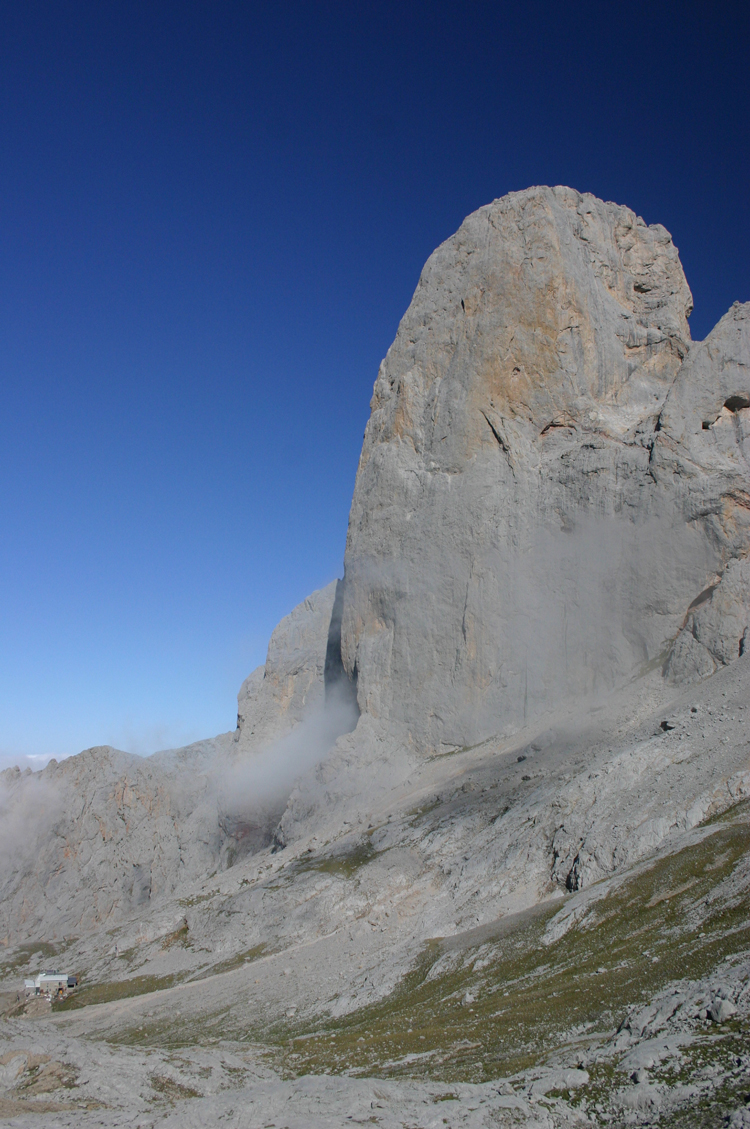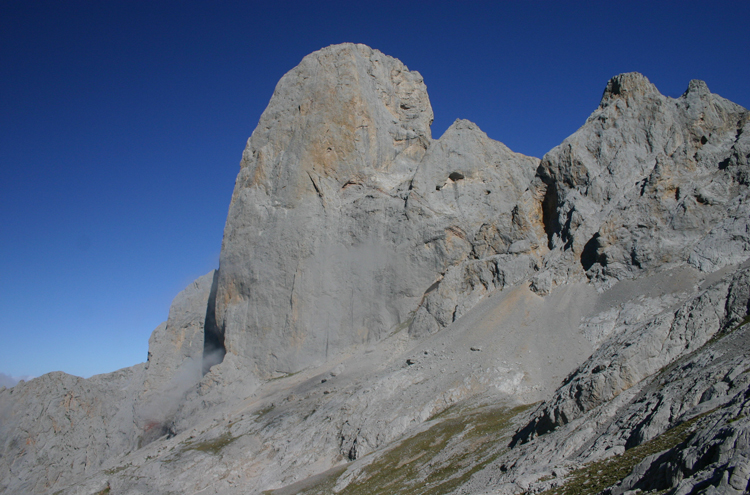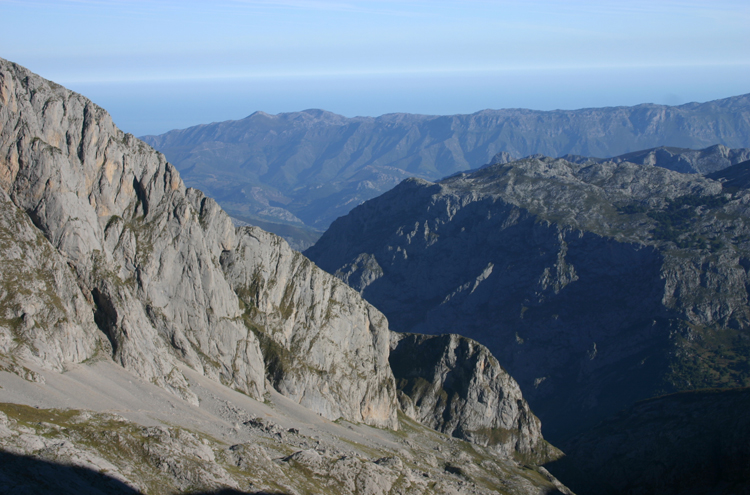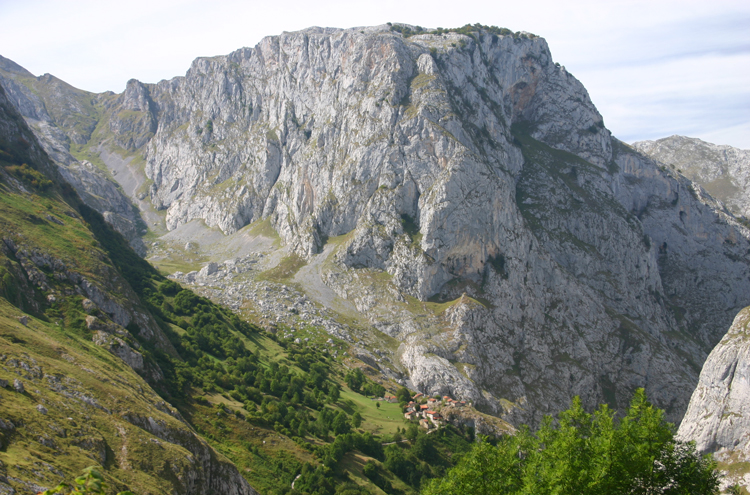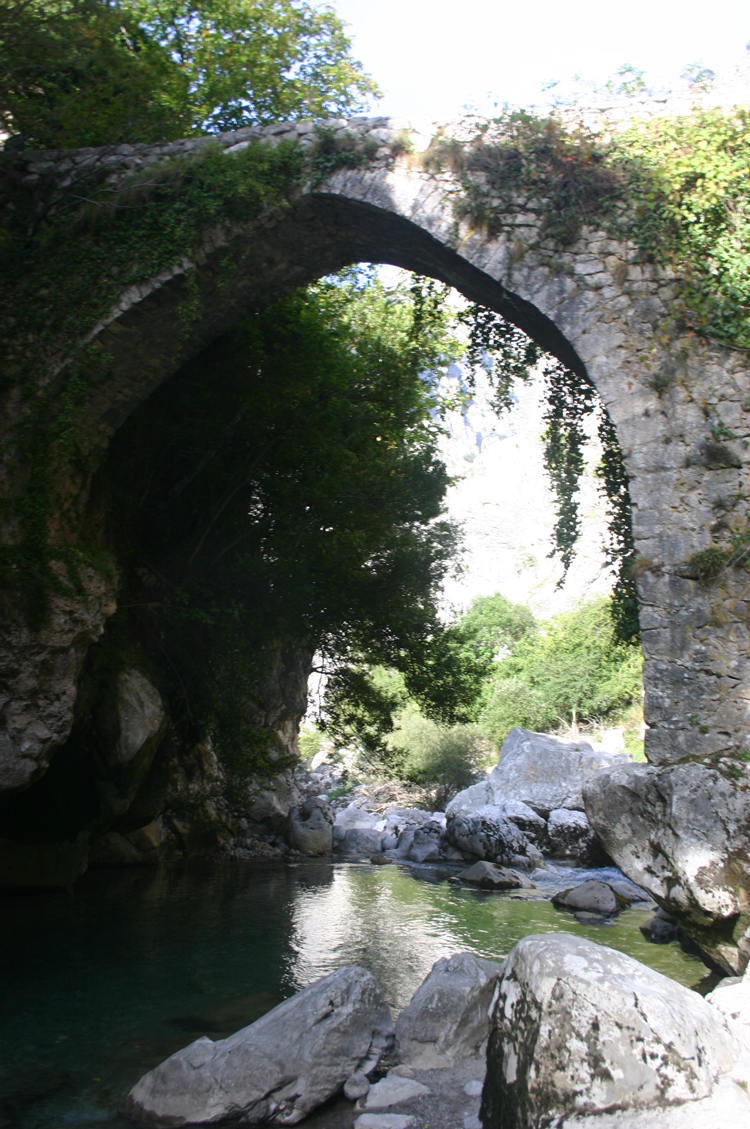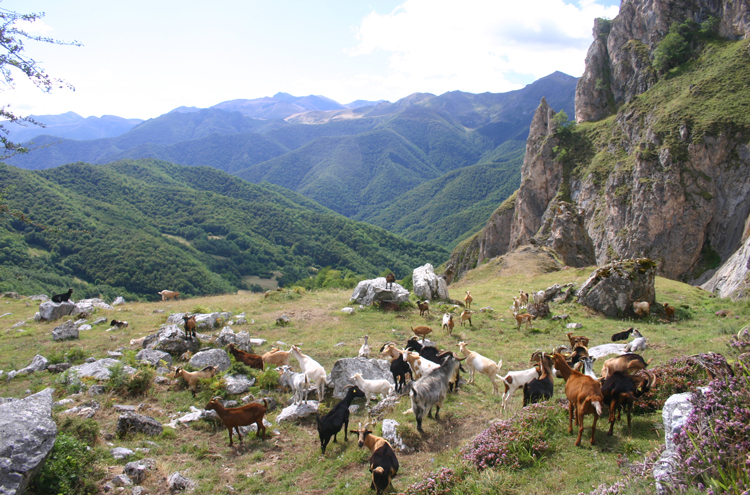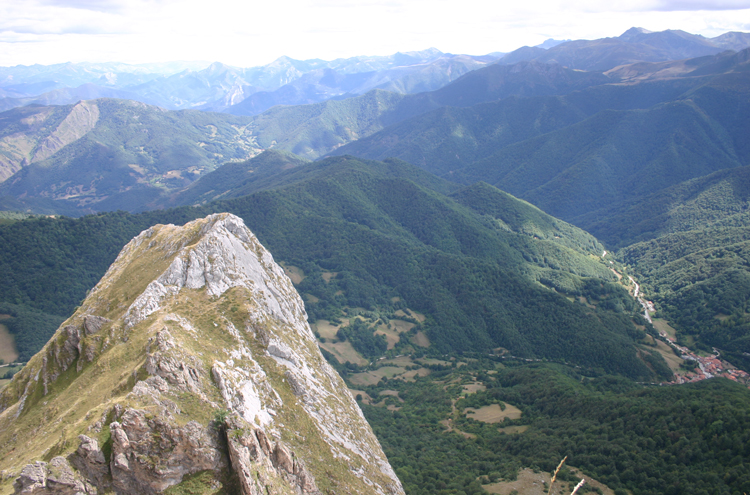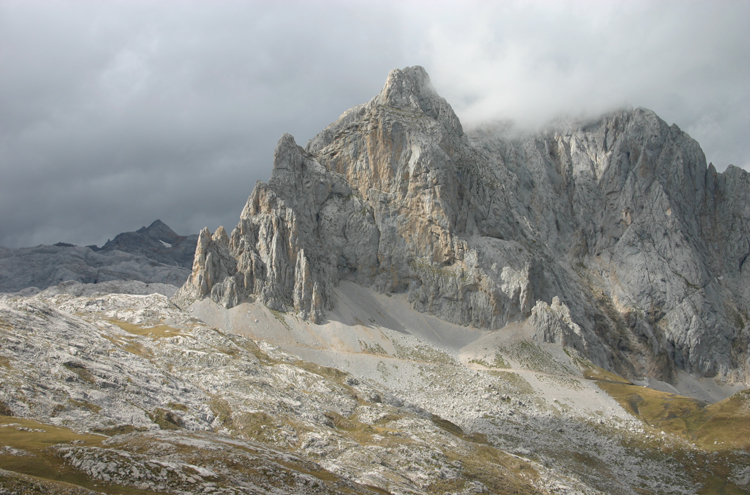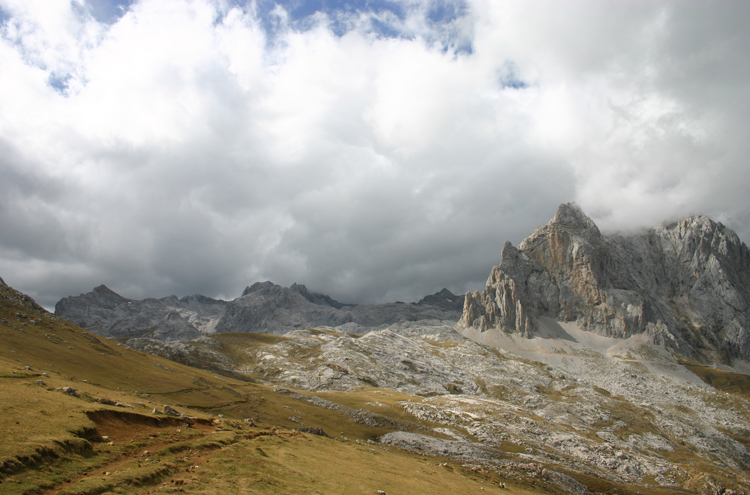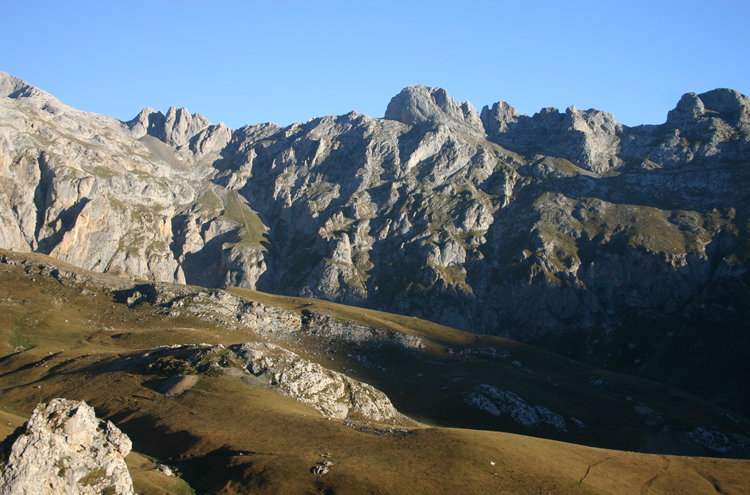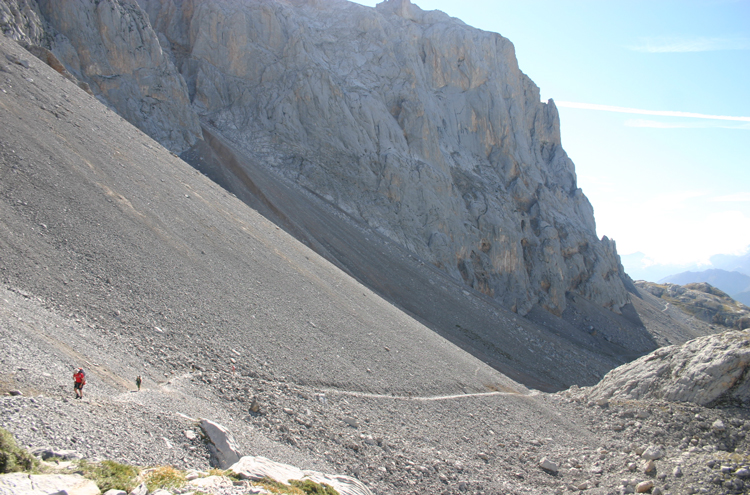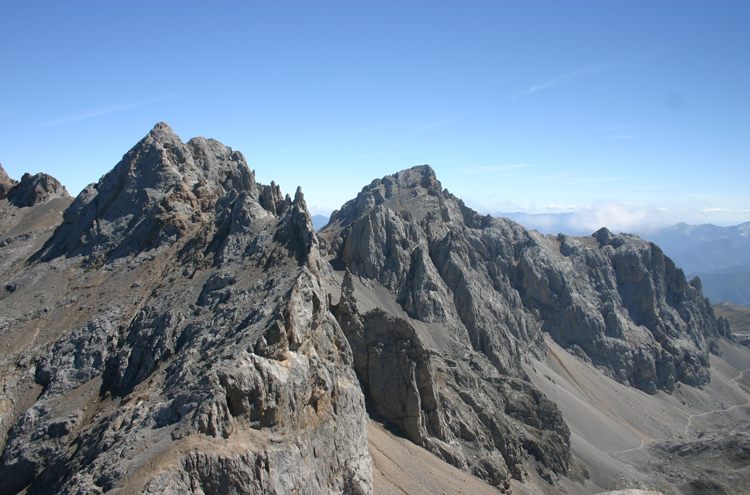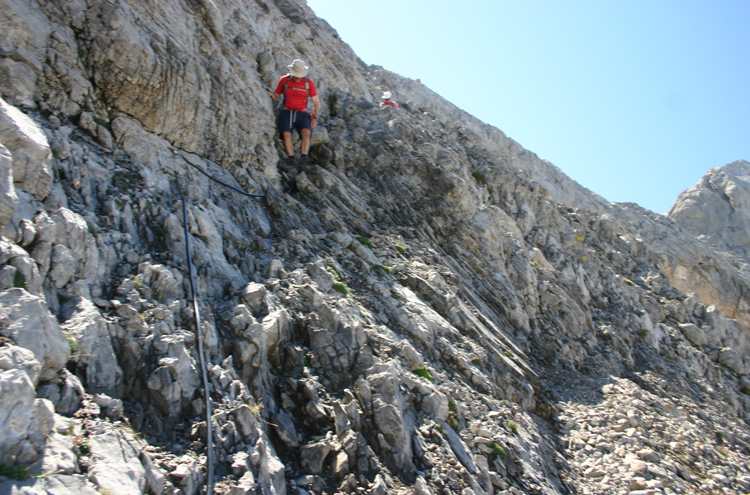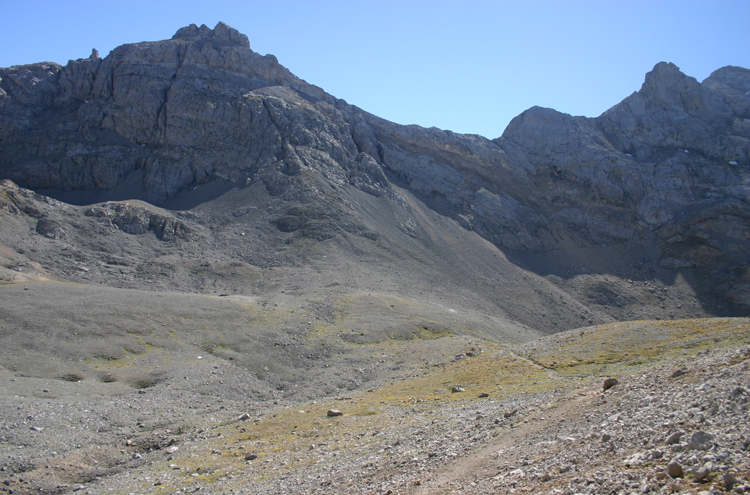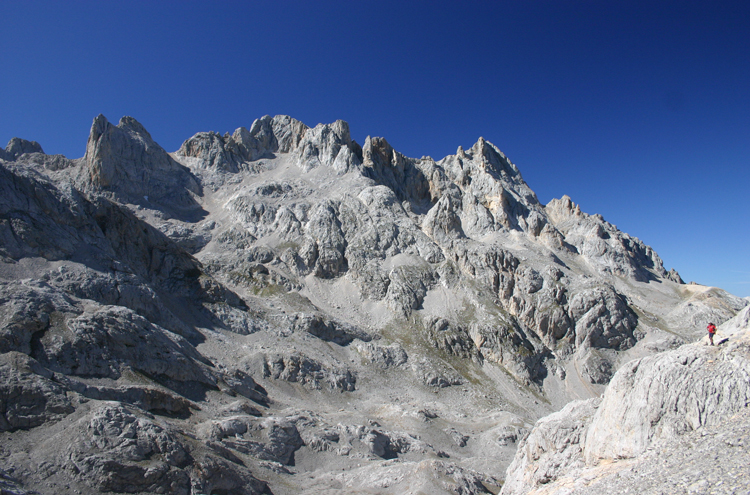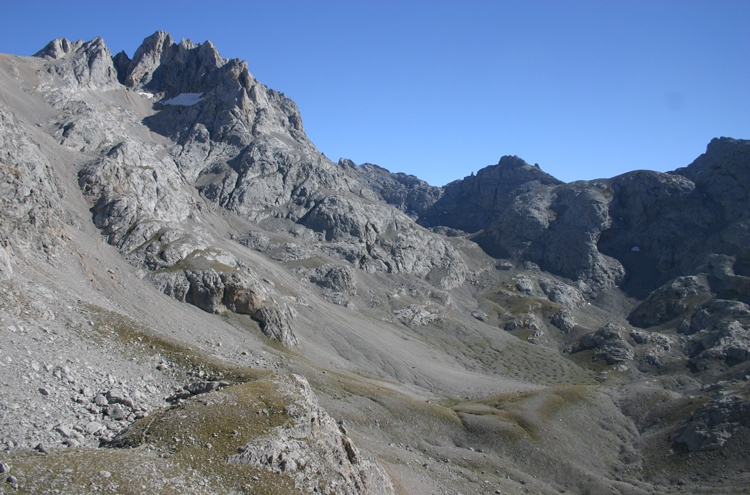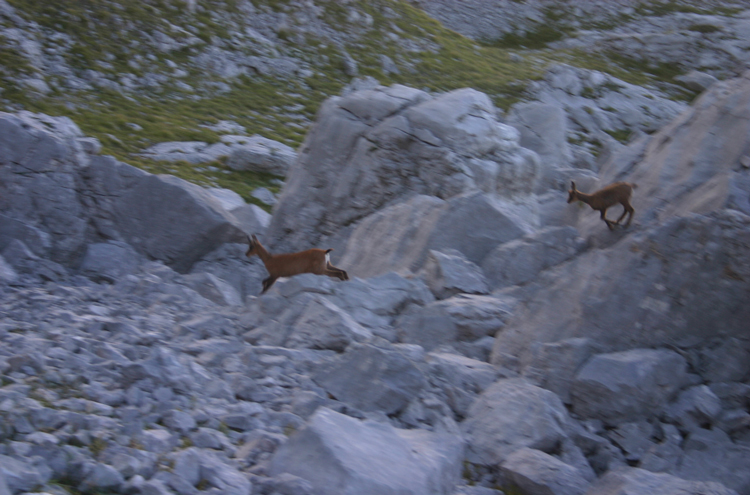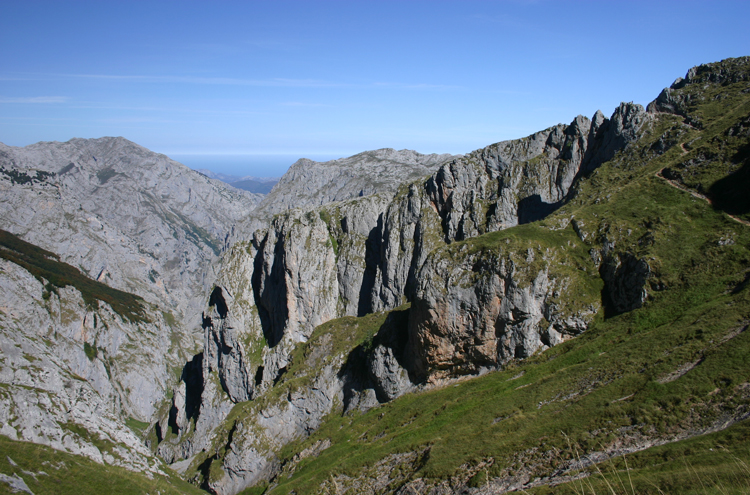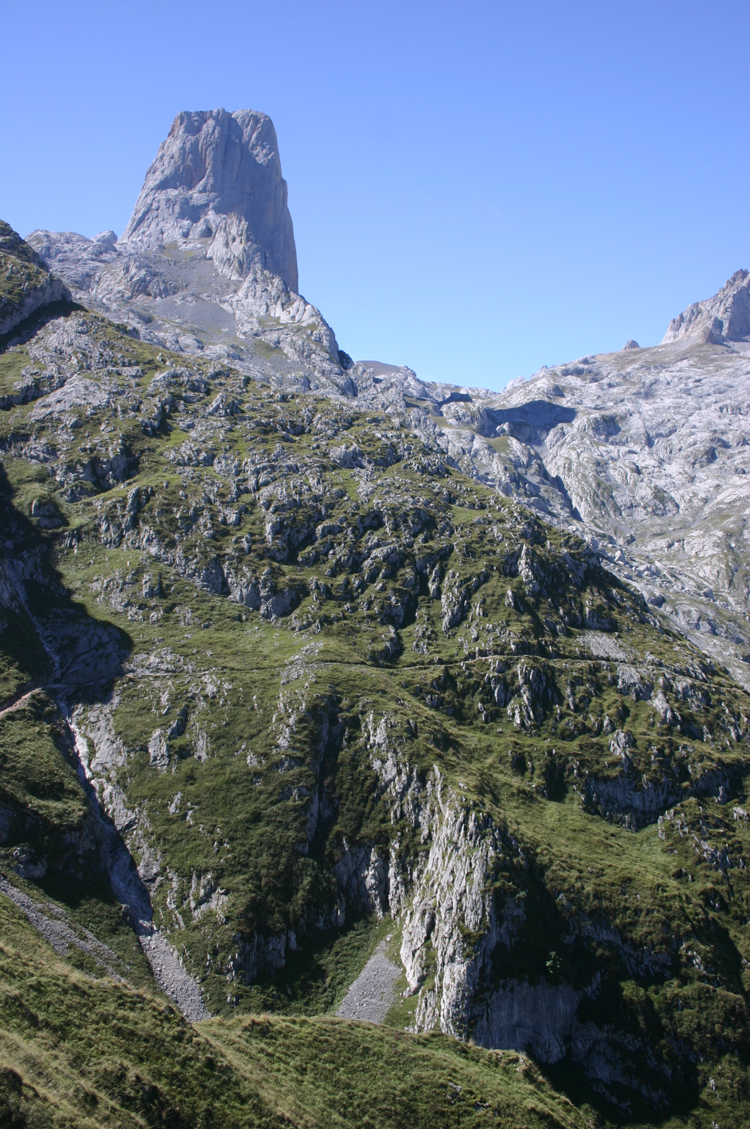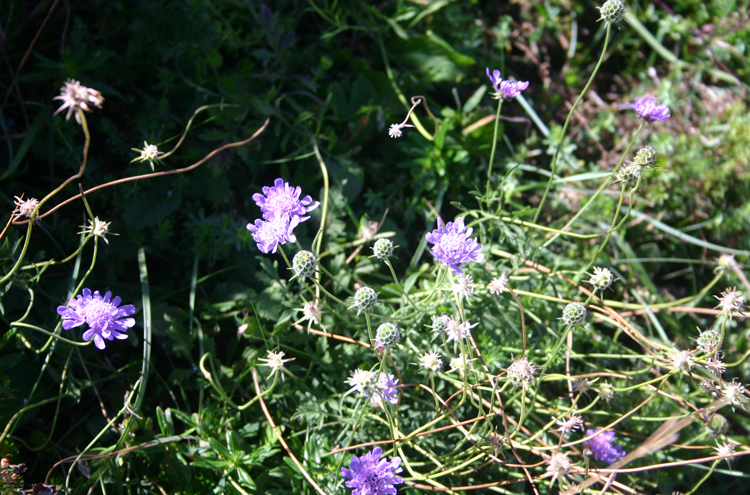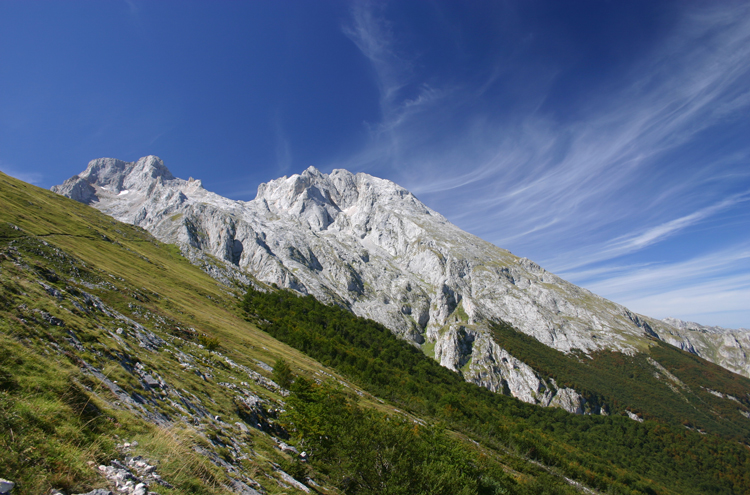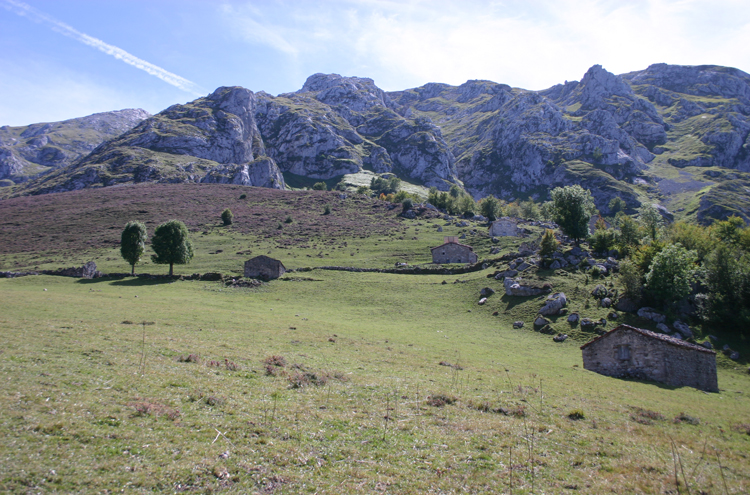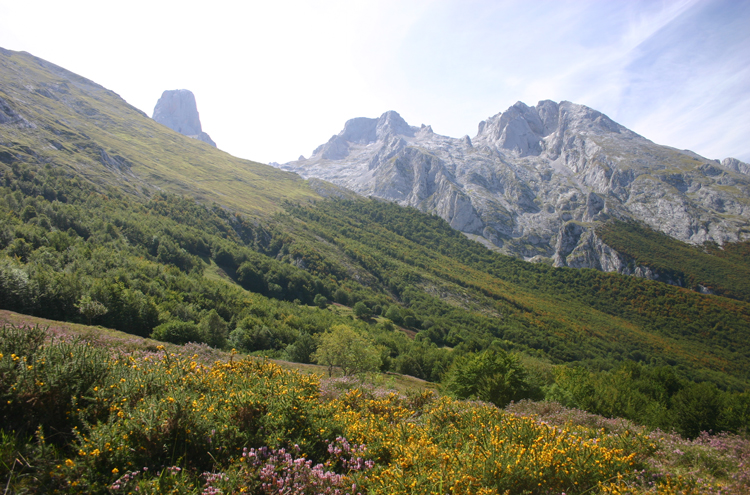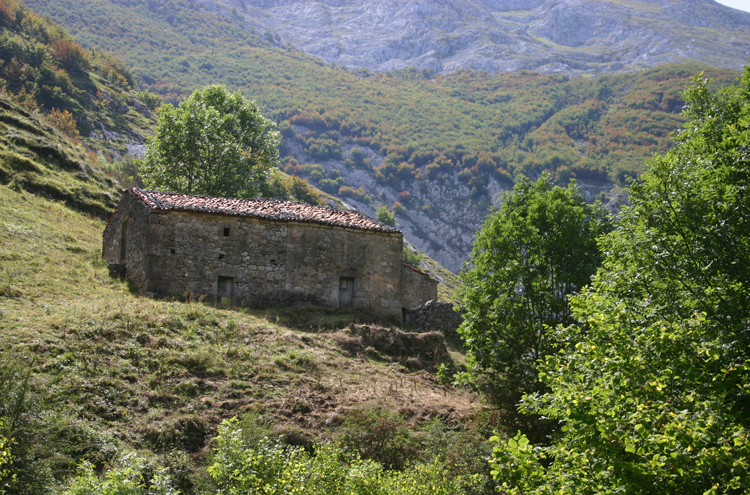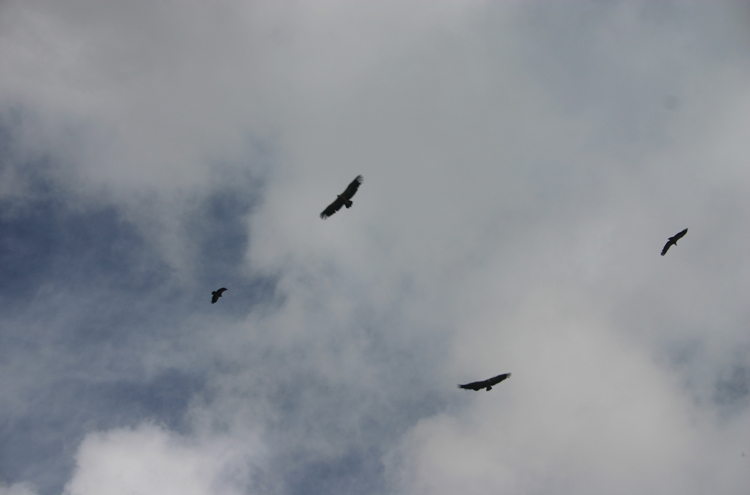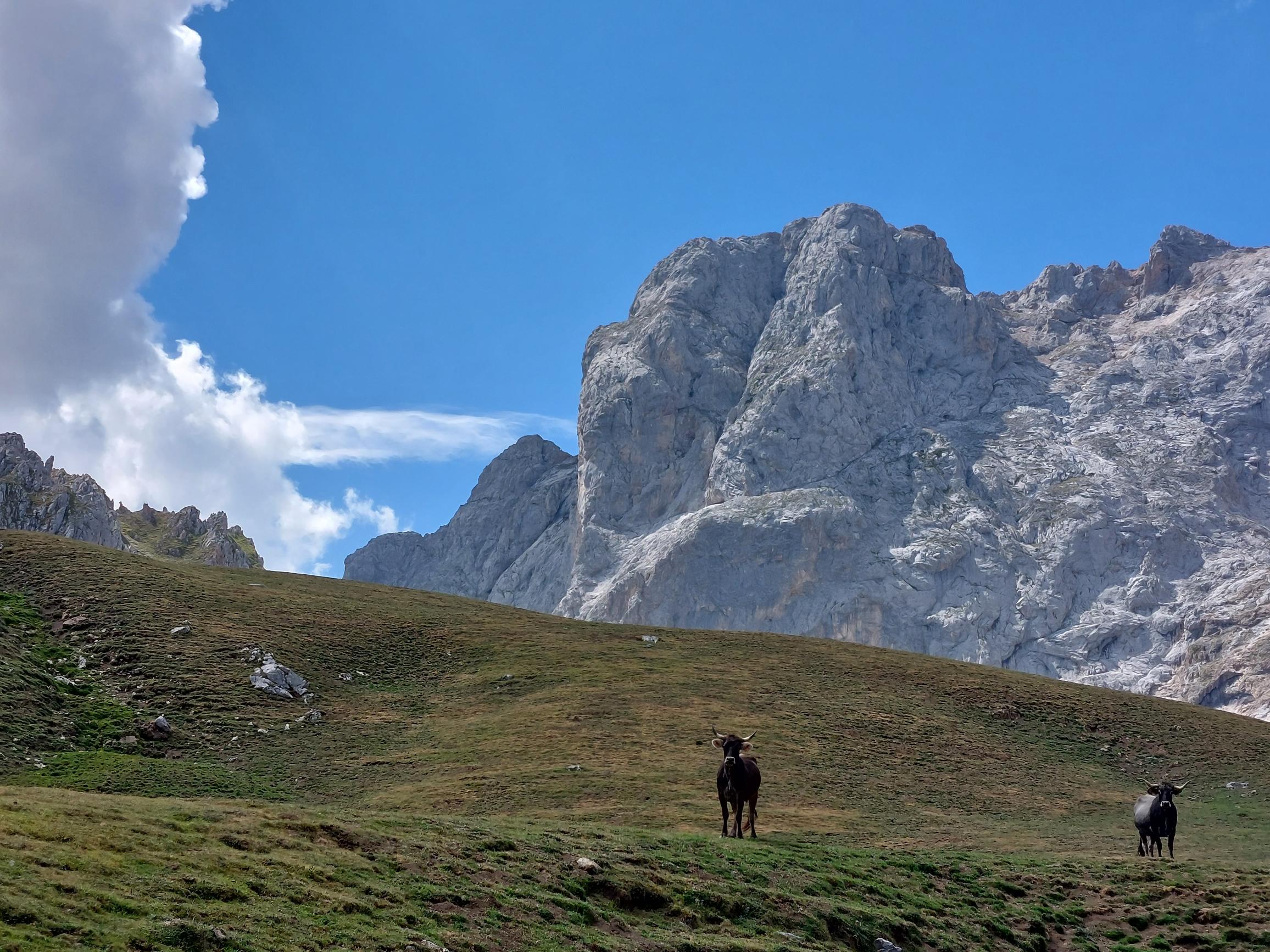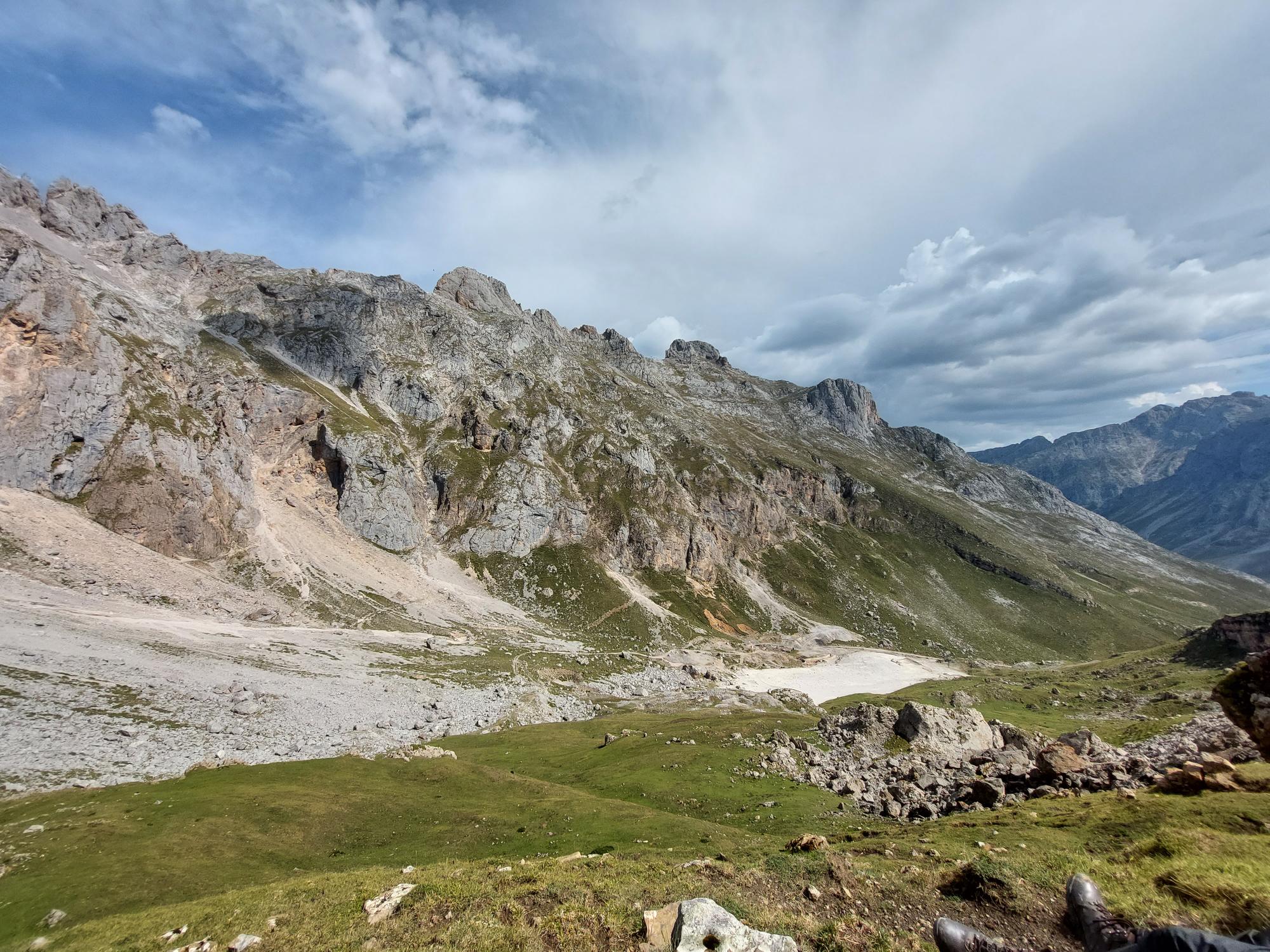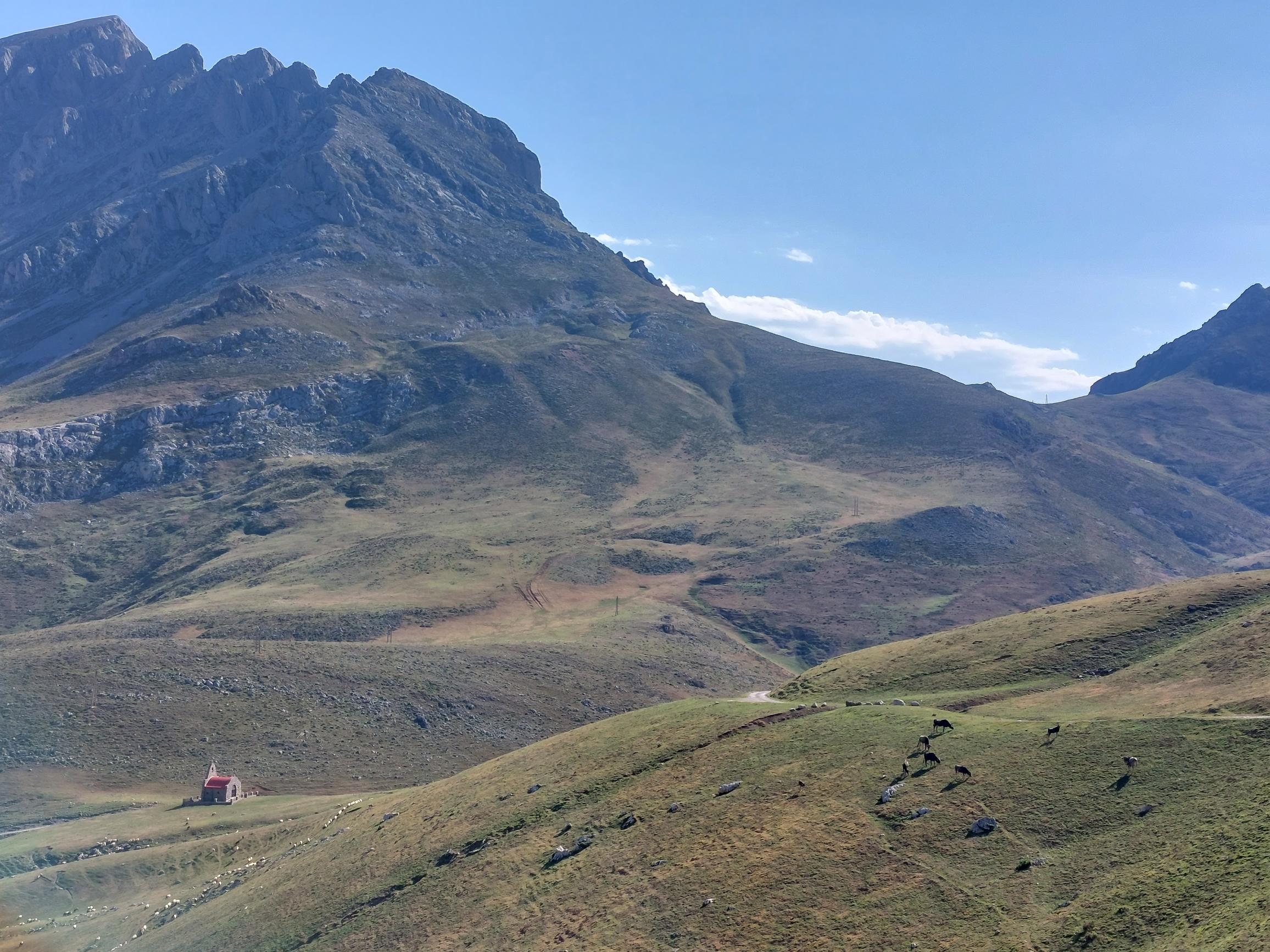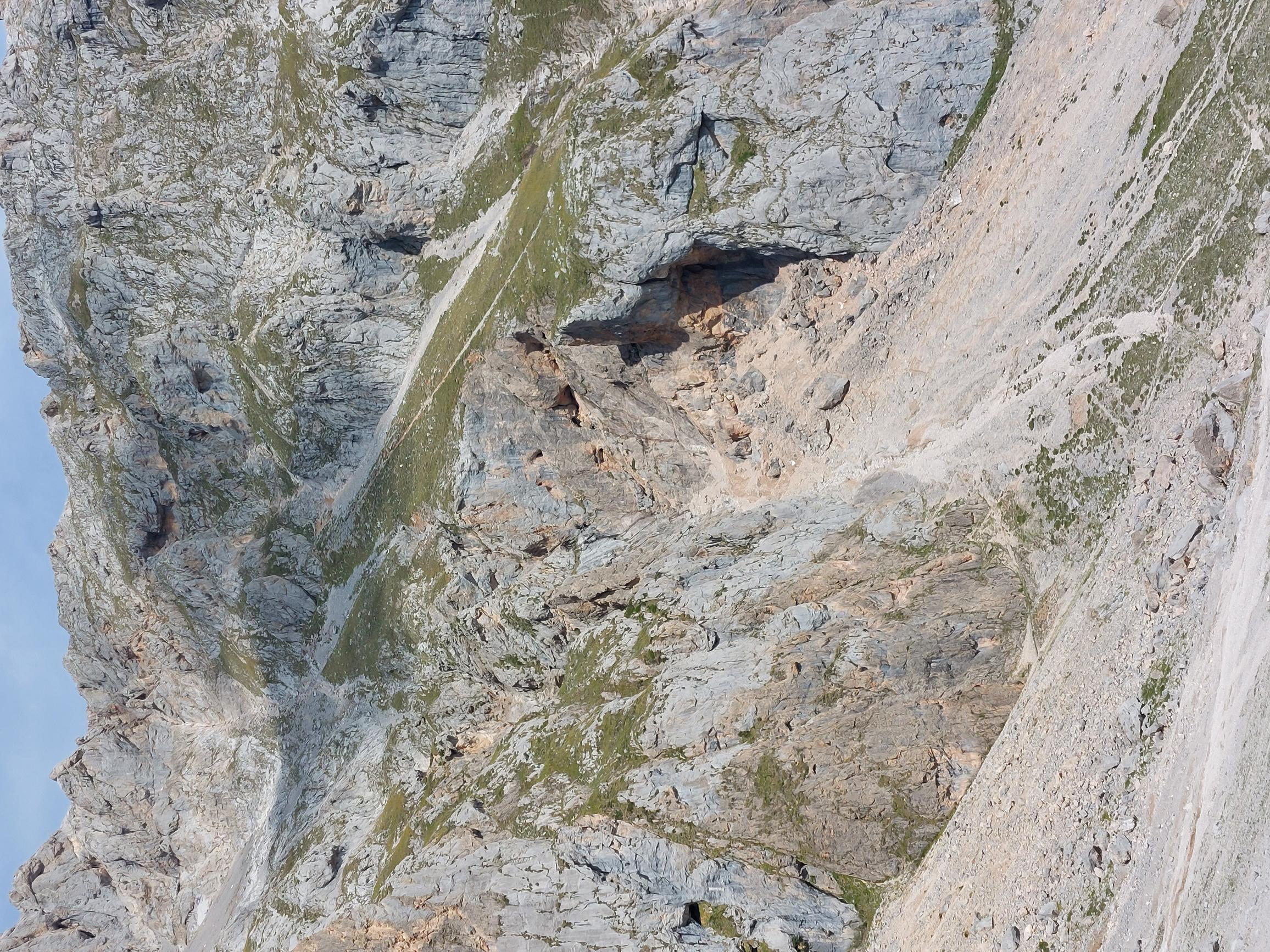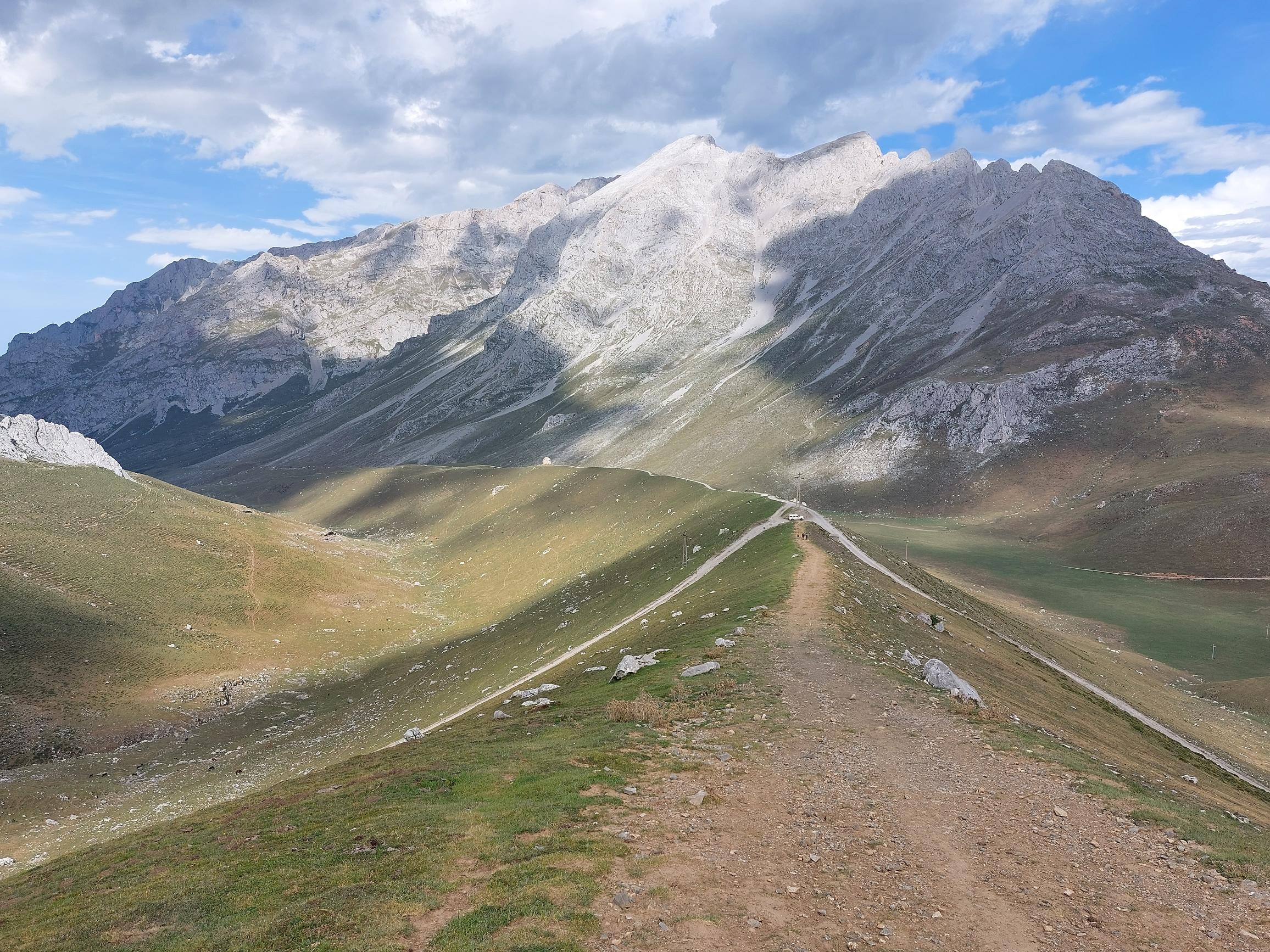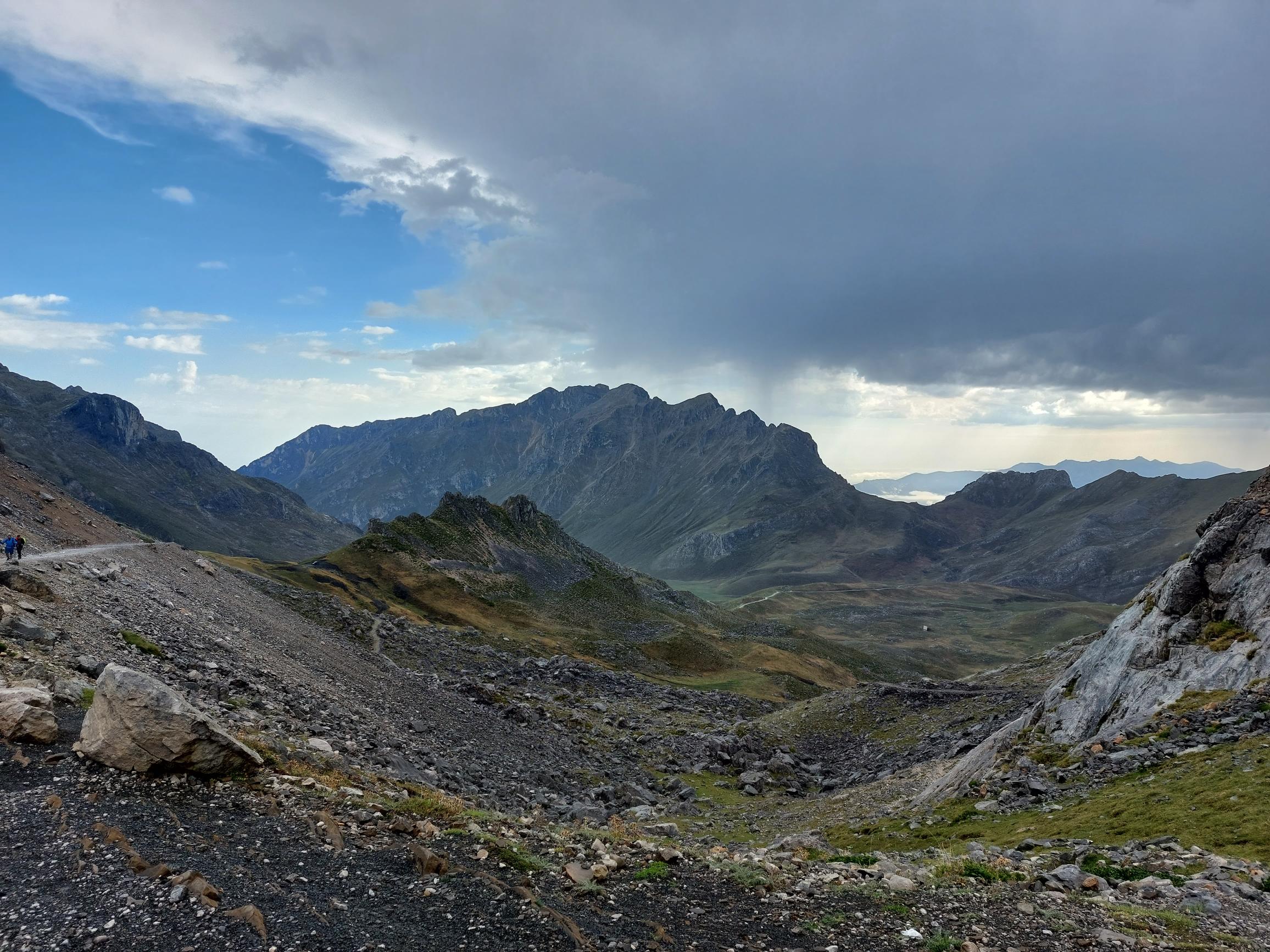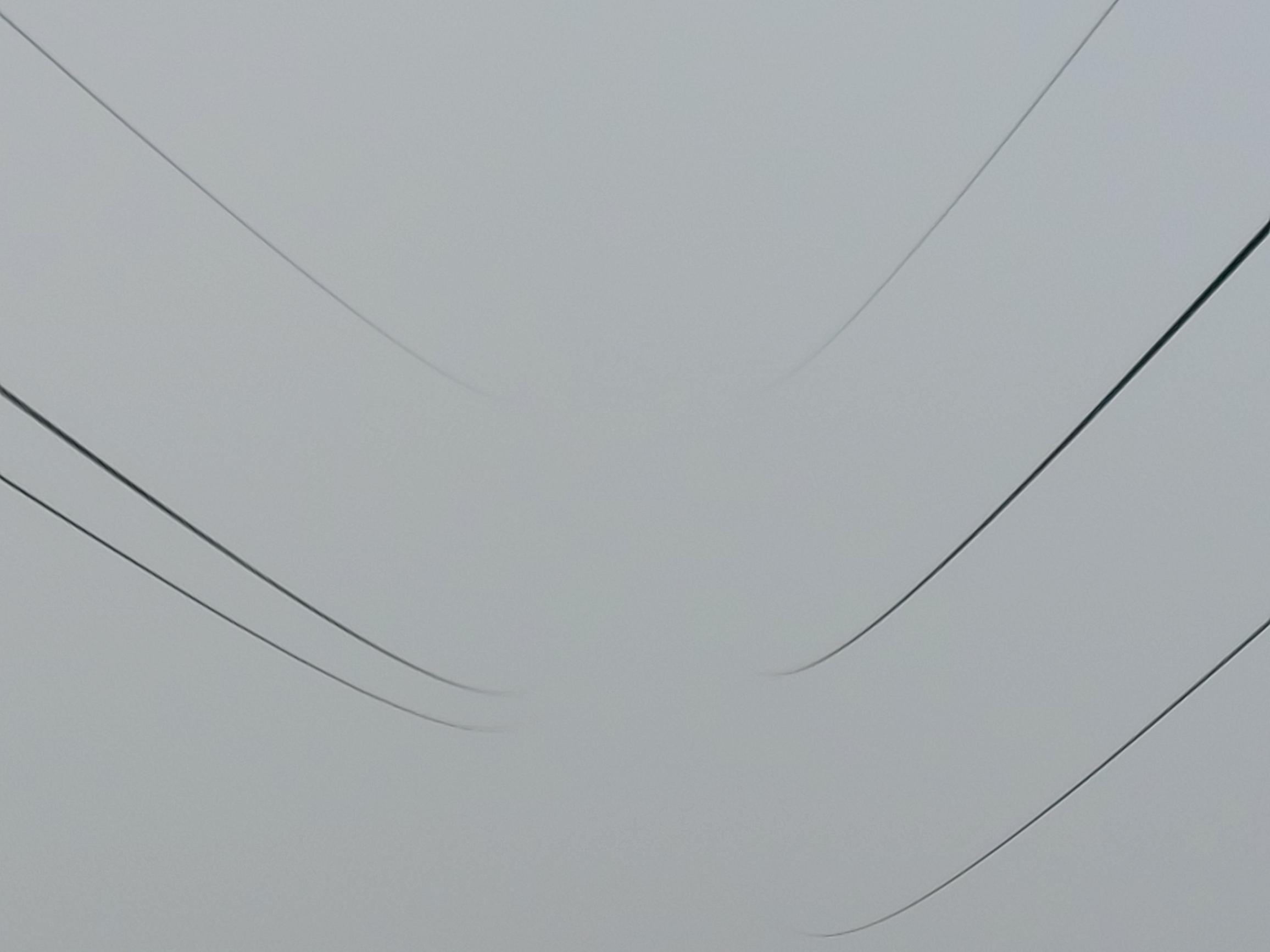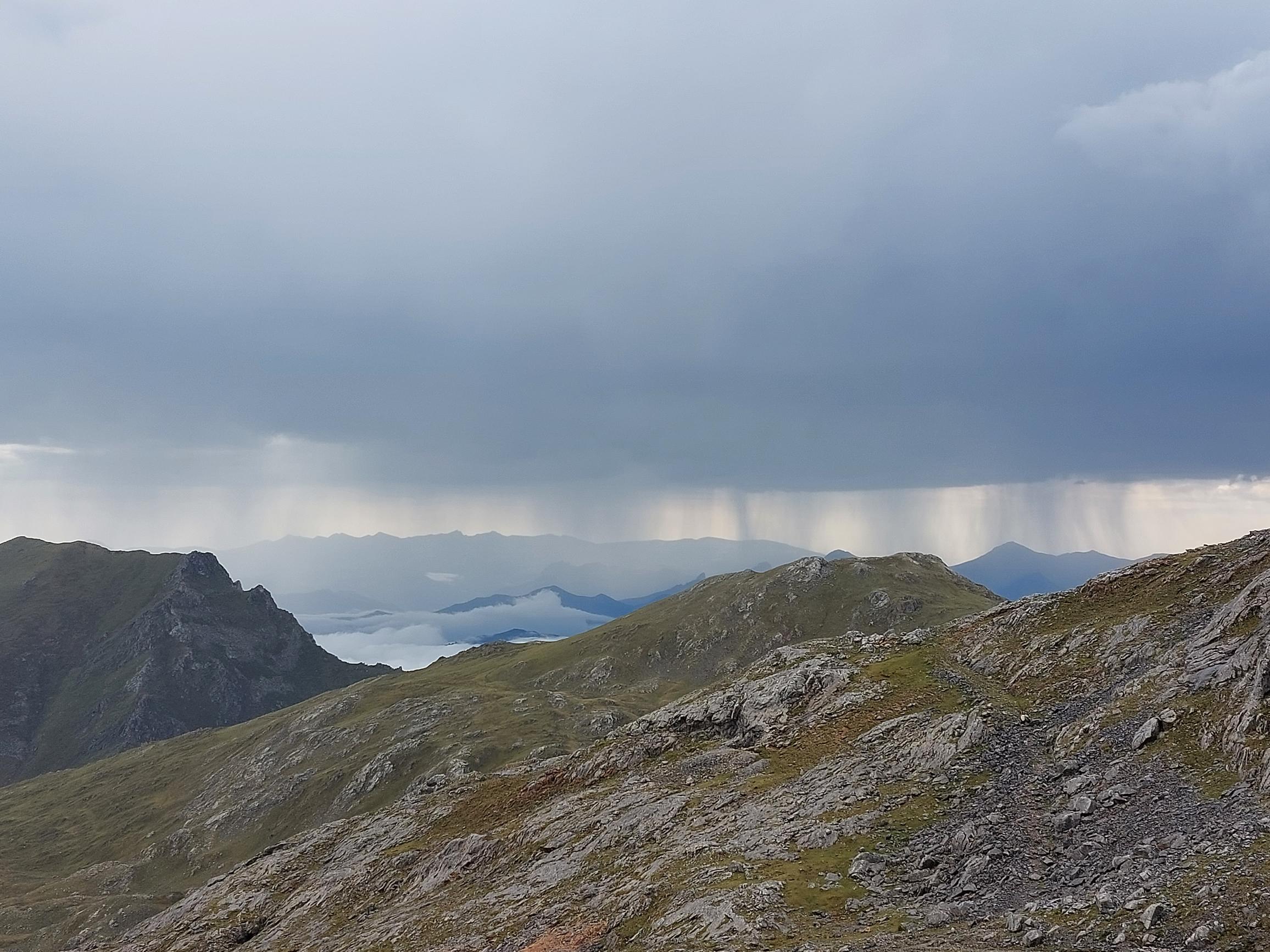Central Picos Traverse
Key information: Central Picos Traverse 
- A 2 or 3 day crossing of this remarkable, jagged range of limestone mountains running along Spain’s northern coast.
- A fantastic variety of scenery, from forests to high summer-grazing land beneath dramatic crags and rocky spires, then tumultuous cracked rock below final high, serrated ridges. Unrivalled flora and fauna.
Walkopedia rating
(Top 100)
- Walkopedia rating92
- Beauty35
- Natural interest16
- Human interest8
- Charisma33
- Negative points0
- Total rating92
Vital Statistics
- Length: 2-3 days
- Maximum Altitude: Around 2,500m
- Level of Difficulty: Strenuous
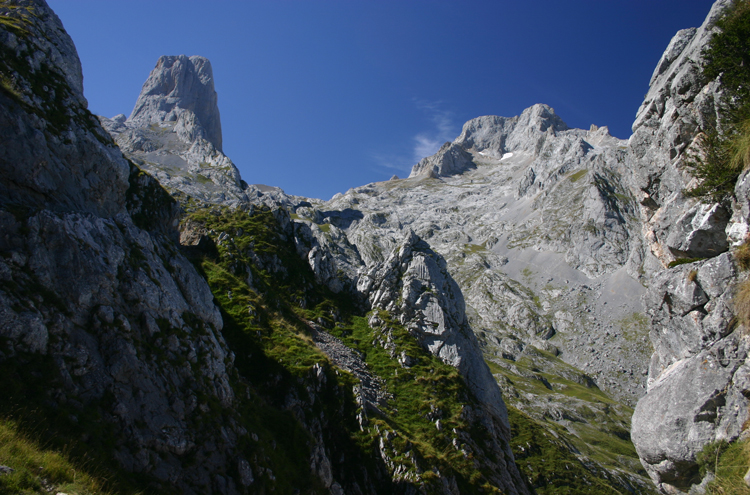
WALK SUMMARY
The central massif of the Picos de Europa in northern Spain is generally thought to be its finest, and a south-north traverse the ultimate walk in the area – only bettered by linking it with the Cares Gorge and the Jermoso Traverse to create the perfect Picos circuit.
There are various ways to cross the central massif; this version is based on one refined by climber and adventurer Geraldine Westrupp.
Day 1:
Start in the village of Espiñama a few kilometres down the valley from the roadhead and cable car station at Fuente Dé, heading north up a small road, then up steep 4WD tracks through delightful mixed forest. After a couple of hours, you reach the red-tiled summer hamlet of Joyo de Iquedri, nestling in steep meadows below the great upper the cliffs. (You can also start from the base of the cable car at Fuente Dé, and ascend gradually through pretty woodlands in a bit under 2hrs, joining the Espinama track just below the cliffs.)
You can head on up the track through a defile and into the great Aliva bowl, an area of cracked limestone and small pasture all surrounded by tremendous cliffs, and work round the hillsides on easy track to the Ref. Aliva, more a hotel, really, with plain but comfortable rooms.
Or you can climb westwards, up onto the rough high ground behind the Fuente Dé cirque. Turning west a short way above the great cliffs, you wind up into a glorious high valley between its own dramatic cliffs. At the crest, the immense bowl of cliffs around Fuente Dé will induce gasps and giddy exhilaration. Then traverse back to Pico del Valdecoro, the first great bastion of the Picos, with tremendous views southward across the lower Cantabrian mountains.
You can then trek along behind the northern cliffs towards the top cable car station and turn north to head and through a gap at the base 2,406m Peña Alvidada and out into the top of the huge Aliva bowl. Another half-hour or so’s walking gets you to the refuge. Or you can wind across the broken ground northern-east from the Collada de la Junciana and reach the refuge along the track from the east.
(If you are short of time (or don’t feel like starting with a 2,500ft climb), you can take the cable car from Fuente Dé, gaining some 750m (but beware queues of up to 2hrs at popular times; come out of high season, or get there early – and note that flexible entry to the cable car comes with booking the Aliva Hotel, although do check for luck), then either walk to Ref. Aliva or, if you want to do the traverse in two rather than three days, join Day 2 below the Peña Olvidada.)
Day 2 starts with a steady hike up a good track to the 1,967m col immediately below the Peña Olvidada, passing an old royal hunting lodge.
Rounding the corner, turn into the northward glen heading up toward the heart of the Central Massif, revelling in the wonders around you: the enormous cliffs of the Peña Vieja and other peaks of the central ridge, with endless scree-slopes below them, loom immediately over your right. West and south is the smashed devastation of the Hoyo Sin Tierra, a remarkably deep sinkhole even by the standards of this limestone range, a great ring of cliffs and spires marking the skyline behind it.
A long, steady climb gets to the Horcados Rojos pass at the very heart of the range. Climb on to the Torre de los Horcados Rojos for lunch. It is hard work, with brief exposure at the very top, but rewards with extravagant views all around: peaks, cliffs and exiguous high meadows basking under a cloudless sky.
Back at the col, tackle the expedition’s heartstopper (for some), a 300m cable-assisted descent of a broken cliff, starting with a traverse, then a descent down a series of steep fissures, then directly down the slightly less precipitous lower slopes. A fall could easily be fatal, but it isn’t that dangerous in good weather. Great care would be needed in the wet.
At the base, you skirt another couple of great hous in the long valley bottom, dry as all water disappears into those great sieves. This is fabulous walking, with magnificent cliffs and high, serrated ridges on both sides.
At a final ridgetop, the giddy, smooth western face of the Naranjo comes into full view, glowing orange in the afternoon sun on a clear day. Nestled below it is the Ubeda refuge, in the most spectacular of settings, a (relatively) level patch of meadow on the valley bottom surrounded by spires. Although over-cosy upstairs – rows of crammed-together bunk mattresses – the downstairs is gemütlich enough.
Day 3 starts with a long descent into the gorge below the Naranjo, the path dropping quickly between vast boulders. Then traverse below the magnificent eastern cliffs of the deepening gorge, with increasingly exciting views back up to the Naranjo. Around a corner from the final viewpoint, you are suddenly in a very different world – forest and meadow, with a really delightful steady descent across the hillsides to a tiny refuge in a summer hamlet.
Then on down on cropped grassland, through a scattering of summer steadings, then drop into the forest for a while and a tedious descent over old but very uneven cobbles to the atmospheric hamlet of Bulnes. After descending more than 1,300m, you will sorely need a drink before continuing on for another hour and a half through the outstanding Canal del Texu gorge, once again frequently on ancient mule and cattle tracks high in the cliffs. Emerge at the base of the even more extraordinary Cares Gorge, crossing a perfect old Roman bridge spanning the Cares stream. But don’t miss a painfully refreshing dip in its montane waters. Marvellous……
A version that Walkopedia would love to return and tackle would be the high traverse from the Aliva hotel to the refuge J.D.Ubeda under the Naranjo de Bulnes rock. This climbs to cross the broken, dramatic high ground which is surrounded by the central Picos’ highest crags and summits before edging out through a short but exciting canyon to the Ubeda refuge. Note that this is very dangerous, and should only be tackled by the experienced and well-prepared, not alone and perhaps with a guide.
Sotres circuit: Another option, which avoids the Fuente De cablecar, is to start at Sotres in the North, walk south up the superb Valle del Dudje to the Aliva refuge, take the Central Picos Traverse across the heart of the range to the Naranjo de Bulnes and on north down the gorge above Bulnes, then swinging east across the high pastures to drop back in to the lower Dudje valley and back to Sotres.
This is high country, exposed to Atlantic weather; rain is common, trails can get cut off by snow in winter, and the area is famous for sudden and dramatic mists. Come prepared.
See our Picos de Europa page for general and important practical information about the Picos and this walk.
WILLIAM MACKESY'S ACCOUNT
of this walk
There are various ways to cross the central massif; this version has been refined by climber and adventurer Geraldine Westrupp.
You start in the lovely and unspoilt village of Espiñama a few kilometres down the valley from the roadhead and cable car station at Fuente Dé, heading north up a small road, then up steep tracks through delightful mixed forest, catching occasional glimpses of pastures and approaching cliffs and high country.
After a couple of hours, you reach the red-tiled summer hamlet of Joyo de Iquedri, nestling in the steep meadows below the first.....
READ MOREOther accounts: share your experiences
Your comments on this walk, your experiences and suggestions, and your photos are very welcome. Where appropriate, you will be credited for your contribution.
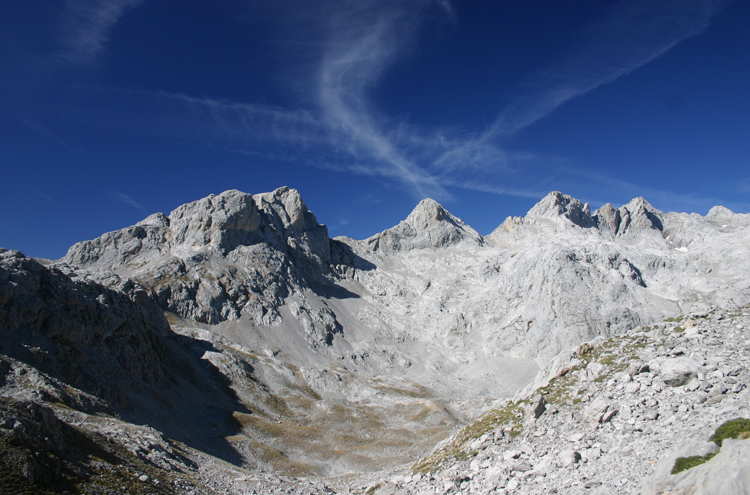
Safety and problems: All walks have inherent risks and potential problems, and many of the walks featured on this website involve significant risks, dangers and problems. Problems of any sort can arise on any walk. This website does not purport to identify any (or all) actual or potential risks, dangers and problems that may relate to any particular walk.
Any person who is considering undertaking this walk should do careful research and make their own assessment of the risks, dangers and possible problems involved. They should also go to “Important information” for further important information.
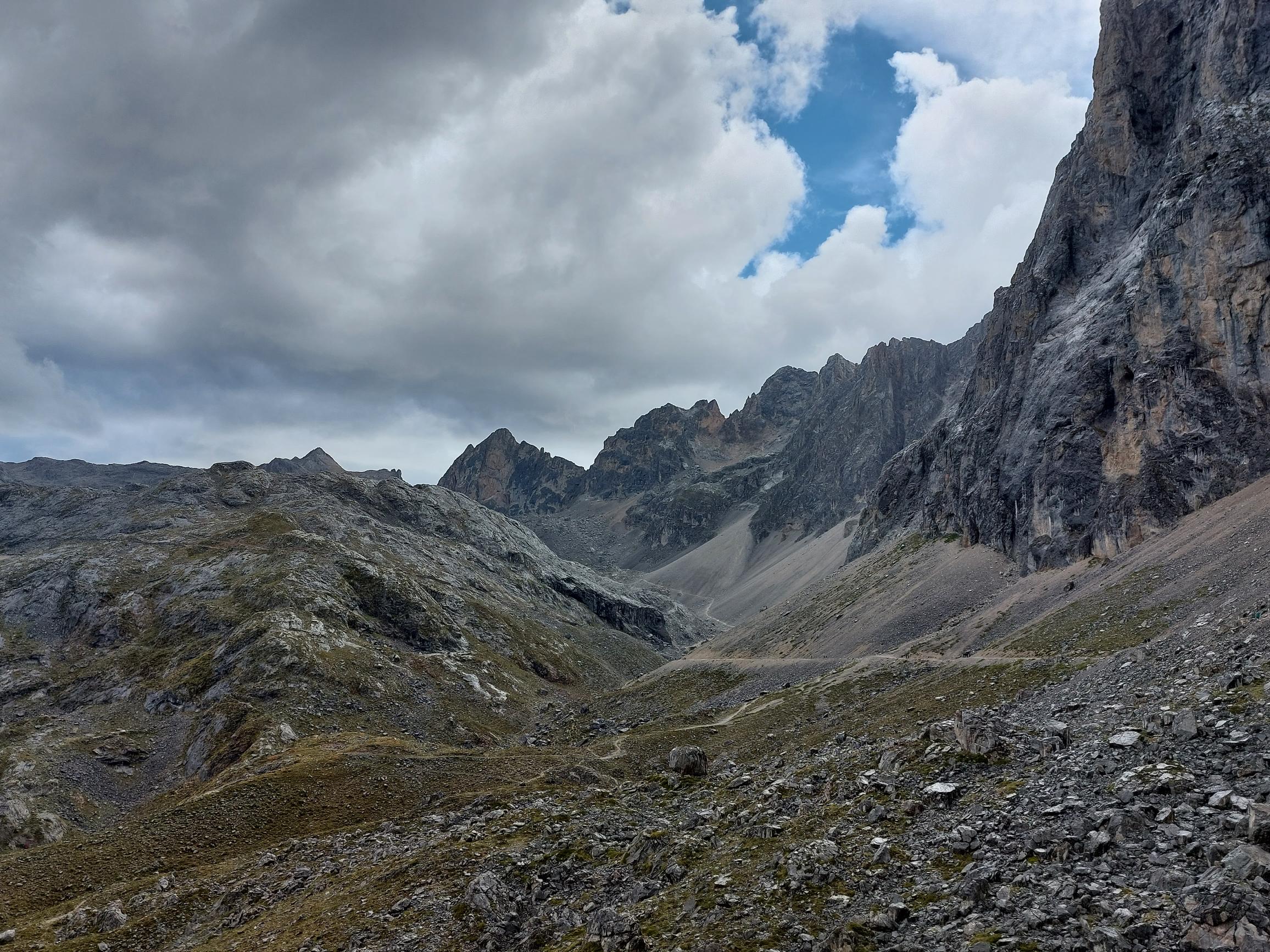
Anyone planning an expedition to this place should see further important information about this walk.
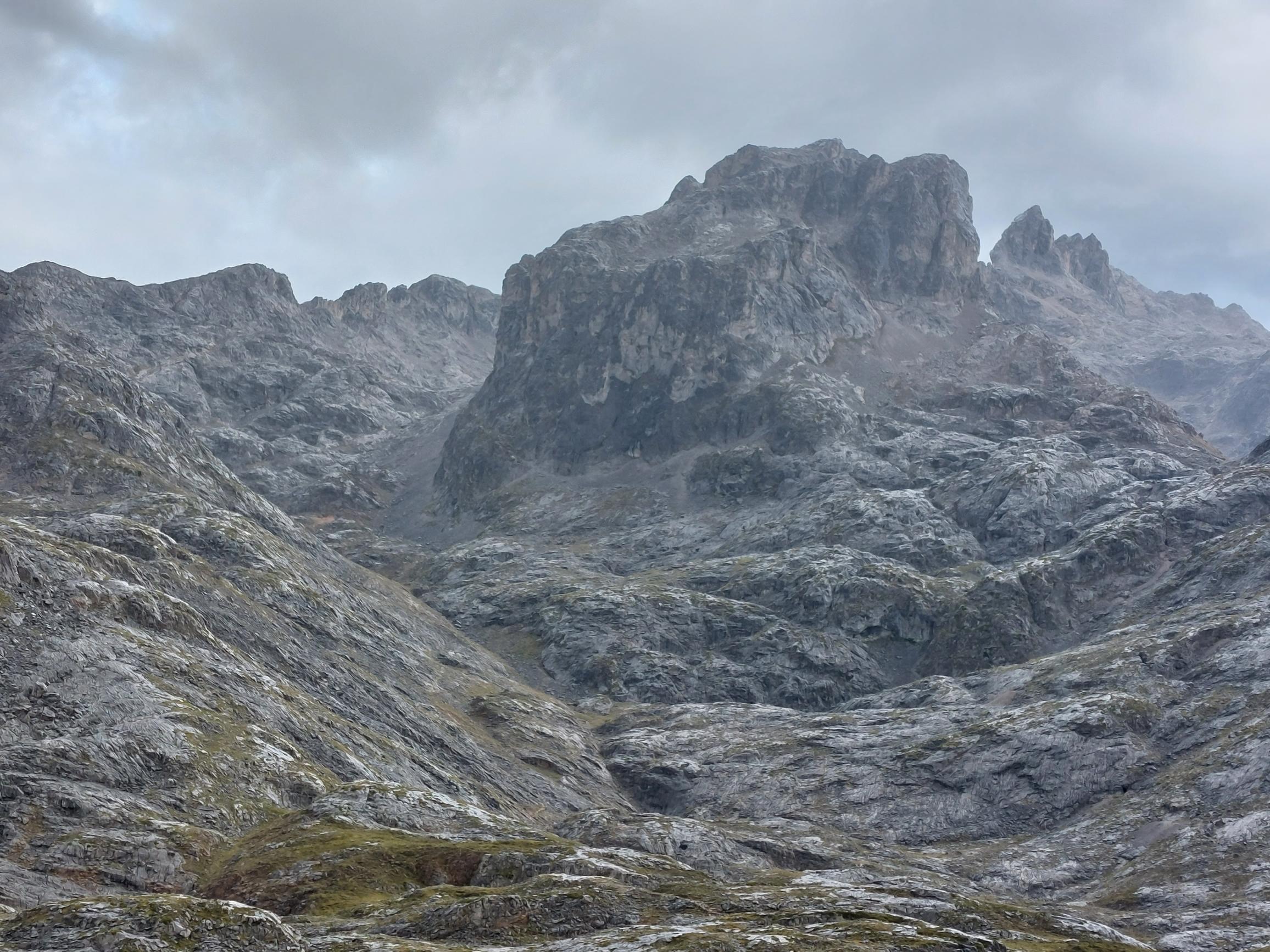
Responsible travel matters, a lot. How you travel will make a real difference - for better or worse. PLEASE consider this when making plans. Read more



